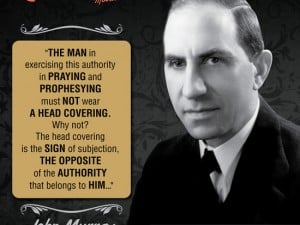How do we Harmonize 1 Corinthians 11 and 14?

In 1 Corinthians 11, women are told that they are to pray or prophesy in the assembly with a head covering. However, later on in the letter Paul says that women are forbidden to speak and must stay silent in the same context. How do we harmonize these two passages?
First, let’s read the two verses in question:
But every woman who prays or prophesies with her head uncovered dishonors her head… Judge for yourselves: Is it proper for a woman to pray to God with her head uncovered? (1 Cor 11:5,13)
As in all the churches of the saints, the women should be silent in the churches, for they are not permitted to speak, but should be submissive, as the law also says. And if they want to learn something, they should ask their own husbands at home, for it is disgraceful for a woman to speak in the church meeting. (1 Cor 14:33a-35 HCSB)
The first thing we must note is that both passages are timeless. Paul says that the practice of head covering and the silence of women in the assembly are held by all the churches (1 Cor 11:16, 1 Cor 14:33-34 HCSB) and both issues are grounded in proper biblical authority (1 Cor 11:3, 1 Cor 14:34). So both must be taken seriously and have application to the church today.
There are three main ways to harmonize these passages. We’ll go over each of these one by one and then we’ll give our take on which one we find most compelling.
View #1: Not the assembly.
The first view believes that when women are “praying and prophesying” (1 Cor 11:5) that this is not referring to the local assembly context. So it may refer to what she does in a womens group, at home, or other non-church settings. In contrast, women being “silent in the churches” (1 Cor 14:33a-35) is referring to the local assembly. So all tension is removed because Paul is addressing two different settings. “Silent” is understood by most in its literal sense to mean a woman doesn’t verbally lead in any aspect of corporate worship.
Here’s how one biblical commentator articulates this view:
“There is no contradiction between 1 Corinthians 11:5 of our chapter and 1 Corinthians 14:34, for the simple reason that there speaking in the assembly is in question, whereas in our chapter the assembly does not come into view until verse 1 Corinthians 11:17 is reached. Only then do we begin to consider things that may happen when we “come together.” The praying or prophesying contemplated in verse 1 Corinthians 11:5 is not in connection with the formal assemblies of God’s saints.” – F.B. Hole 1) Frank Binford Hole – “Commentary on 1 Corinthians 11:1”. “F. B. Hole’s Old and New Testament Commentary”. “http://www.studylight.org/commentaries/fbh/view.cgi?bk=45&ch=11“. 1947.
View #2. Hypothetical praying.
The second view believes that both women praying (1 Cor 11:5) and being silent (1 Cor 14:34) are referring to the same local assembly setting. This view understands Paul as dealing with two different issues, one at a time. First he deals with women being unveiled, without mentioning the fact that speaking itself is forbidden. Then when the topic comes up, he states his view clearly that it is improper for women to speak in church. So the main distinction of this view is that Paul is not authorizing women to pray in the assembly. He is merely proposing a hypothetical situation to address women unveiling their heads.
Here’s how one biblical commentator articulates this view:
“Yet it might appear here that St. Paul is contradicting what he said in the other passage, namely that it is not permitted for a woman to teach. If that is true, how is it that he here attributes to her the charge and office of prophesying? The answer is that St. Paul did not mean to put the women in the pulpit; rather he proposed a (hypothetical) case, just as we are accustomed to doing. It is a common enough way of speaking. Let us suppose that a woman were preaching, or leading in prayer (as does the one who serves as a common mouth), and that her head was uncovered during such an activity. What about it? Everyone would be horrified by such a spectacle.” – John Calvin 2) John Calvin – Men, Women, and Order in the Church: Three Sermons (Presbyterian Heritage Publications, 1992) page 29
View #3. Limited silence.
The third view also agrees that women praying (1 Cor 11:5) and being silent (1 Cor 14:34) are referring to the same local assembly setting. This view does believe that Paul is authorizing women to pray and prophesy in church. The main distinction of this view is that “being silent” is not a prohibition against all speech, but specific speech. Paul had just told the tongue speaker who doesn’t have an interpreter that they are to “keep silent in church and speak to himself and to God” (1 Cor 14:28). So the “keep silent” in that verse is not total, but about speaking out loud in tongues. In the same way, women “being silent” is referring to unsubmissive speech (1 Cor 14:34) which is most often identified as judging prophecies (1 Cor 14:29).
Here’s how one biblical commentator articulates this view:
“The verse is meaningless unless women were from time to time moved, in the Christian assembly in Corinth, to pray and prophesy aloud and in public (not simply in family prayers and other small groups—Bachmann). If moreover Paul had thought it wrong for them to do this he would certainly not have wasted time in discussing what, in these circumstances, they should do with their heads; he would simply have forbidden the practice.” -C.K. Barrett 3) C.K. Barrett – The First Epistle to the Corinthians (Black’s New Testament Commentaries) (A&C Black Publishers, 1987) page 250
The Challenge
We must admit that harmonizing these two passages is not an easy task. There isn’t a “neat-and-tidy” explanation that handles the apparent discrepancy easily. Whenever you’re trying to harmonize two passages you always interpret the clearer in light of the less clear. Also if you’re having a hard time making an interpretive decision, it’s always best to err on the side of caution. However, there is no safe option in this case. If you take women being silent as clearer, when that was not what was meant, then you’ve denied women the freedom to participate in aspects of corporate worship that God desires them to. If on the other hand you take women praying as the clearer, when that was not what was meant, you end up having women participating in something God did not intend for them to do. Both have serious consequences as one is contrary to God’s established order in the church. So we must wrestle hard with these Scriptures and be convinced in our minds of what Paul meant.
Our View
Our own understanding is the “limited silence” view. So that means we have no problem with women speaking publicly (but not preaching) if they wear a head covering. We take this position because we believe the structure of 1 Corinthians 11 provides a compelling case for why the “praying and prophesying” is referring to corporate worship. This understanding is supported by virtually all biblical commentators. 4) John MacArthur and F.B. Hole are two notable commentators that don’t take this position. While we will freely admit that understanding “silence” as referring to all public speech is the more natural reading, the various attempts 5) The predominate harmonization in early commentaries is that Paul is referring to extraordinary circumstances where women are supernaturally prompted by the Spirit to speak. So their natural disposition is silence, but in those certain rare circumstances she may speak. to explain away Paul’s references to women speaking (1 Cor 11:5) are unsatisfactory. Because of this we end up taking the “silence” in a limited sense as it is less clear than the authorized “praying and prophesying”.
References
- Is Head Covering Related to Spiritual Gifts? A Response to Barry York - July 5, 2023
- A Husband’s Authority is Limited (He is Not Pastor or King) - November 14, 2022
- Statement from Jeremy Gardiner: Leadership Transition - September 26, 2022



